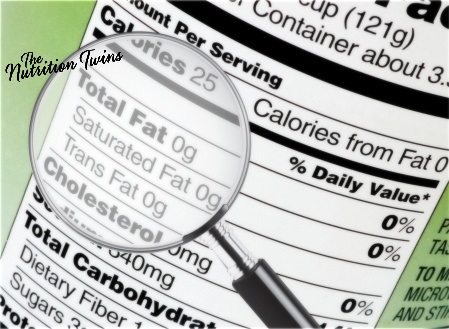As registered dietitian nutritionists, we’ve been witnessing our clients use the food labels over the years to guide them to make healthy decisions. While for the most part, the labels have been extremely helpful in steering them to make the best decisions, there have been several shortcomings that have caused confusion. So we’re excited about the Food and Drug Administration’s (FDA’s) proposed changes for the new nutrition label as it seems that they will likely be addressing a number of these shortcomings!
One of our favorites of the proposed changes is listing added sugars. We’ve continually witnessed consumer confusion as they have used the sugar information on a label to guide their decisions. Unlike naturally occurring sugars found in milk and fruit, added sugars are added during processing. Calories from added sugars contribute calories without adding any nutrients or fiber but consumers seemed confused by seeing “sugar” on the label and assuming it’s all the same for their health. We’ve witnessed scores of consumers misuse this information to make an erroneous decision for their health. For instance, we’ve seen people decide to stay away from a yogurt that is packed with protein and calcium and that has no added sugar simply because they read the food label and see that the yogurt’s sugar content seems high—although it’s simply from naturally occurring lactose (milk sugar). We’re hopeful consumers will start being able to make smart choices as they clearly will be able see when a sugar is added to a food by a manufacturer.
Admittedly, as helpful as we do hope this change is, we do spot a potential downside– loopholes when it comes to added sugars. For example, rice malt/ syrups (trisaccharides) aren’t considered “sugars” (they have a different particle size than sugar) and can get off the hook from being called out as an added sugar on the label, while table sugar (disaccharide) is considered an added sugar, even though the body breaks table sugar down the same way it breaks down rice malt and syrups. So it’s really important for a meaningful definition to be established, otherwise the consumer will continue to be deceived.
Getting rid of “calories from fat” is also a change we’re all for. Just like simply seeing “Sugar” on the label, it’s confusing, and doesn’t distinguish between healthy fats (monounsaturated and polyunsaturated fats) and artery-clogging ones such as saturated and trans fats.
More realistic serving sizes? Yes, please! We’re fans of this proposed change. We’re hopeful that gone will be the days of eating a muffin and believing you consumed the amount of calories indicated on the label only to later learn, the calories listed were for one-quarter of the muffin. Too many people have been there and “muffed” that up. Our only fear with this change is that it will give people a license to eat more; perhaps they would have only eaten half the muffin before, but now that they see a serving is the entire muffin, they may eat it all. This is why education regarding this label is as important as ever. People need to be educated that the serving is not a suggested serving size, rather a common serving size.
We’re fans of seeing new labels with calorie counts in bold letters. The bigger, the bolder,–the more in your face, the less likely you’ll be to overlook it. Even if you’re not seeking out this information, and you see it, it may guide someone to make a healthier decision.
As RDNs, we’re happy that the nutrients that Americans need more of— for example, potassium and vitamin D—are proposed to be included on the label, but for the most part, we believe that this information will be irrelevant to many consumers as they likely won’t know any difference from seeing this information compared to Vitamins A and C. So although this is a nice change for those that understand this information, for most people, this will be meaningless. Also, we would prefer for vitamin A and C to still be listed. Showing vitamin A and vitamin C content may help to encourage people to eat more fruits and vegetables.
Additional downsides? As we mentioned in situations such as the change to a more realistic serving size on the new label, it will still be very important that the food label is explained to prevent confusion. Although it will be packed with information—all of which has the potential to be very helpful and empowering, if people don’t understand the information they are given, it won’t do them any good. Also, we’re going to have to be patient as many of these changes may take up to another two years.
So, until then, continue to eat plenty of fruits and veggies—since you know what you are getting and they don’t need to have a label to tell you that they are GOOD STUFF! 🙂



